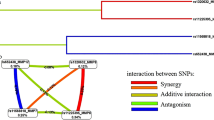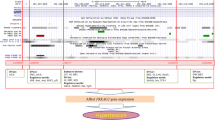Abstract
Essential hypertension (EH) is a significant health issue around the globe. The indifferent therapy regimen suggests varied physiological functions due to the lifestyle and genetic presentations of an individual. The endothelial nitric oxide synthase (NOS3) gene is a crucial vascular system marker in EH that contributes significantly to the phenotype. Hence, the present study aimed to employ the candidate gene approach and investigate the association between NOS3 single nucleotide polymorphism (SNP) E298D (G894T/rs1799983) by applying several in silico tools and validation through human samples screening. We corroborated computational findings through a case-control study comprising 294 controls and 299 patients; the 894T allele emerged significantly as the risk allele (odds ratio=2.07; P=6.38E−05). The in silico analyses highlighted the significance of E298D on the native structure and function of NOS3. The dynamics simulation study revealed that the variant type 298D caused structural destabilization of the protein to alter its function. Plasma nitrite levels were reduced in patients (P=0.0002), and the same correlated with the 894T allele. Furthermore, correlations were apparent between clinical, genotype, and routine biochemical parameters. To conclude, the study demonstrated a perceptible association between the SNP E298D and NOS3 protein structure stability that appears to have a bearing on the enzyme’s function with a deleterious role in EH.







Similar content being viewed by others
Availability of data and material
NA.
Code availability
NA.
References
Carretero OA, Oparil S (2000) Essential hypertension. Part I: Definition and etiology. Circulation 101:329–335. https://doi.org/10.1161/01.cir.101.3.329
Chobanian AV (2001) Control of hypertension: an important national priority. N Engl J Med 345:534–535. https://doi.org/10.1056/NEJM200108163450709
Kearney PM, Whelton M, Reynolds K (2005) Global burden of hypertension: analysis of worldwide data. Lancet 365:217–223. https://doi.org/10.1016/S0140-673605.17741-1
Benjamin EJ, Blaha MJ, Chiuve SE (2007) Heart disease and stroke statistics-2017 update: a report from the American Heart Association. Circulation 135:e646. https://doi.org/10.1161/CIR.0000000000000485
Arnett DK, Claas SA, Glasser SP (2006) Pharmacogenetics of antihypertensive treatment. Vasc Pharmacol 44:107–118. https://doi.org/10.1016/j.vph.2005.09.010
Oliveira-Paula GH, Lacchini R, Tanus-Santos JE (2016) Endothelial nitric oxide synthase: from biochemistry and gene structure to clinical implications of NOS3 polymorphisms. Gene 57:584–599. https://doi.org/10.1016/j.gene.2015.09.061
Oliveira-Paula GH, Lacchini R, Tanus-Santos JE (2017) Clinical and pharmacogenetic impact of endothelial nitric oxide synthase polymorphisms on cardiovascular diseases. Nitric Oxide 63:39–51. https://doi.org/10.1016/j.niox.2016.08.004
Förstermann U, Sessa WC (2012) Nitric oxide synthases: regulation and function. Eur Heart J33:829–837. https://doi.org/10.1093/eurheartj/ehr304
Hingorani AD, Liang CF, Fatibene J (1999) A common variant of the endothelial nitric oxide synthase Glu298 → Asp.is a major risk factor for coronary artery disease in the UK. Circulation 100:1515–1520. https://doi.org/10.1161/01.cir.100.14.1515
Casas JP, Bautista LE, Humphries SE (2004) Endothelial nitric oxide synthase genotype and ischemic heart disease: meta-analysis of 26 studies involving 23,028 subjects. Circulation 109:1359–1365. https://doi.org/10.1161/01.CIR.0000121357.76910.A3
Ahsan A, Norboo T, Baig MA (2004) eNOS allelic variants at the same locus associate with HAPE and adaptation. Thorax 59:1000–1002. https://doi.org/10.1136/thx.2004.029124
Ahsan A, Mohd G, Norboo T (2006) Heterozygotes of NOS3 polymorphisms contribute to reduced nitrogen oxides in high-altitude pulmonary edema. Chest 130:1511–1519. https://doi.org/10.1378/chest.130.5.1511
Nejatizadeh A, Kumar R, Stobdan T (2008) Endothelial nitric oxide synthase gene haplotypes and circulating nitric oxide levels significantly associate with risk of essential hypertension. Free Radic Biol Med 44:1912–1918. https://doi.org/10.1016/j.freeradbiomed.2008.02.004
Kumar R, Nejatizadeh A, Arif E (2009) Multi-locus interactions of vascular homeostasis genes in essential hypertension: a gender-based study. Clin Chim Acta 405:87– 93. https://doi.org/10.1016/j.cca.2009.04.010
Kumar R, Nejatizadeh A, Gupta M (2012) The epistasis between vascular homeostasis genes is apparent in essential hypertension. Atherosclerosis 220:418–424. https://doi.org/10.1016/j.atherosclerosis.2011.10.036
Mishra A, Kohli S, Dua S (2015) Genetic differences and aberrant methylation in theapelin system predict the risk of high-altitude pulmonary edema. Proc Natl Acad Sci 112:6134–6139. https://doi.org/10.1073/pnas.1422759112
Jáchymová M, Horký K, Bultas J (2001) Association of the Glu298Asp polymorphism in the endothelial nitric oxide synthase gene with essential hypertension resistant to conventional therapy. Biochem Biophys Res Commun 284:426–430. https://doi.org/10.1006/bbrc.2001.5007
Pasha MAQ, Newman JH (2010) High-altitude disorders: pulmonary hypertension: pulmonary vascular disease: the global perspective. Chest 137:13S–19S. https://doi.org/10.1378/chest.09-2445
Ganesh SK, Arnett DK, Assimes TL (2013) Genetics and genomics for the prevention and treatment of cardiovascular disease: update: a scientific statement from the American Heart Association. Circulation 128:2813–2851. https://doi.org/10.1161/01.cir.0000437913.98912.1d
Stuehr DJ (1997) Structure-function aspects in the nitric oxide synthases. Annu Rev Pharmacol Toxicol 37:339–359. https://doi.org/10.1146/annurev.pharmtox.37.1.339
Ghosh DK, Salerno JC (2003) Nitric oxide synthases: domain structure and alignment in enzyme function and control. Front Biosci 8:d193–d209. https://doi.org/10.2741/959
Savova GK, Masanz JJ, Ogren PV (2010) Mayo clinical Text Analysis and Knowledge Extraction System cTAKES: architecture, component evaluation and applications. J Am Med Inform Assoc 17:507–513. https://doi.org/10.1136/jamia.2009.001560
Xu H, Stenner SP, Doan S (2010) MedEx: a medication information extraction system for clinical narratives. J Am Med Inform Assoc 17:1s9–1s124. https://doi.org/10.1197/jamia.M3378
Peng Y, Alexov E, Basu S (2019) Structural perspective on revealing and altering molecular functions of genetic variants linked with diseases. Int J Mol Sci 20:548. https://doi.org/10.3390/ijms20030548
Stergachis AB, Haugen E, Shafer A (2013) Exonic transcription factor binding directs codon choice and affects protein evolution. Science 342:1367–1372. https://doi.org/10.1126/science.1243490
Basu S, Bhattacharyya D, Banerjee R (2012) Self-complementarity within proteins: bridging the gap between binding and folding. Biophys J 102:2605–2614. https://doi.org/10.1016/j.bpj.2012.04.029
Basu S, Bhattacharyya D, Banerjee R (2014) Applications of complementarity plot in error detection and structure validation of proteins. Indian J Biochem Biophys 51:188–200
Kanipakam H, Sharma K, Thinlas T (2020) Structural and functional alterations of nitric oxide synthase 3 due to missense variants associate with high-altitude pulmonary edema through dynamic study. J Biomol Struct Dyn 17:1–16. https://doi.org/10.1197/jamia.M3378
Abdul SF, Suliman BA, Basha SH (2016) A comprehensive in silico analysis on the structural and functional impact of SNPs in the congenital heart defects associated with NKX2-5 gene - a molecular dynamic simulation approach. PLoS One 11:e0153999. https://doi.org/10.1371/journal.pone.0153999
Bao L, Zhou M, Cui Y (2005) nsSNPAnalyzer: identifying disease associated non-synonymous single nucleotide polymorphisms. Nucleic Acids Res 33:480–482. https://doi.org/10.1093/nar/gki372
Karczewski KJ, Francioli LC, Tiao G (2019) The mutational constraint spectrum quantified from variation in 141,456 humans. BioRxiv 531210. doi:https://doi.org/10.1101/531210.
Rodrigues CH, Pires DE, Ascher DB (2018) DynaMut: predicting the impact of mutations on protein conformation, flexibility and stability. Nucleic Acids Res 46:W350–W355. https://doi.org/10.1093/nar/gky300
Sali A, Blundell TL (1993) Comparative protein modelling by satisfaction of spatial restraints. J Mol Biol 234:79–815. https://doi.org/10.1006/jmbi.1993.1626
Nikolaev DM, Shtyrov AA, Panov MS (2018) A comparative study of modern homology modeling algorithms for rhodopsin structure prediction. ACS Omega 3:7555–7566. https://doi.org/10.1021/acsomega.8b00721
Waterhouse A, Bertoni M, Bienert S (2018) SWISS-MODEL: homology modeling of protein structures and complexes. Nucleic Acids Res 46:296–303. https://doi.org/10.1093/nar/gky427
Kelley LA, Mezulis S, Yates CM (2015) The Phyre2 web portal for protein modeling, prediction and analysis. Nat Protoc 10:845–858. https://doi.org/10.1038/nprot.2015.053
Laskowski RA, Rullmann JA, MacArthur MW (1996) AQUA and PROCHECK-NMR: programs for checking the quality of protein structures solved by NMR. J Biomol NMR 8:477–486. https://doi.org/10.1007/BF00228148
Wallner B, Elofsson A (2003) Can correct protein models be identified? Protein Sci 12:1073–1086. https://doi.org/10.1110/ps.0236803
Wiederstein M, Sippl MJ (2007) ProSA-web: interactive web service for the recognition of errors in three-dimensional structures of proteins. Nucleic Acids Res 35:W407–W410
Bhattacharya M, Hota A, Kar A (2018) In silico structural and functional modeling of Antifreeze protein AFP sequences of Ocean pout Zoarcesamericanus, Bloch & Schneider 1801. J Genet Eng Biotechnol 16:721–730. https://doi.org/10.1016/j.jgeb.2018.08.004
Chen VB, Arendall WB, Headd 3rd JJ (2010) MolProbity: all-atom structure validation for macromolecular crystallography. Acta Crystallogr D Biol Crystallogr 1:12–21. https://doi.org/10.1107/S0907444909042073
DeLano WL (2002) PyMOL: an open-source molecular graphics tool. CCP4 Newsletter on Protein. Crystallography 40:82–92
Desmond Molecular Dynamics System, D. E. Shaw Research, New York, NY (2020) Maestro- Desmond Interoperability Tools. Schrödinger, New York, p 2020
Bowers KJ, Chow E, Xu H (2006) Scalable algorithms for molecular dynamics simulations on commodity clusters. Proceedings of the ACM/IEEE Conference on Supercomputing SC06, Tampa
Samani A, Kawczyński A, Chmura J (2012) Principle component analysis of exposure variation analysis during computer work at presence of delayed onset muscle soreness. Work 41:2387–2391. https://doi.org/10.3233/WOR-2012-0471-2387
Jenik M, Parra RG, Radusky LG (2012) Protein frustratometer: a tool to localize energetic frustration in protein molecules. Nucleic Acids Res 40:W348–W351. https://doi.org/10.1093/nar/gks447
Bhutani I, Loharch S, Gupta P (2015) Structure, dynamics, and interaction of Mycobacterium tuberculosis Mtb. DprE1 and DprE2 examined by molecular modeling, simulation, and electrostatic studies. PLoS One 10:e0119771. https://doi.org/10.1371/journal.pone.0119771
Almeida JG, Preto AJ, Koukos PI (2017) Membrane proteins structures: a review on computational modeling tools. Biochimica et Biophysica Acta (BBA)–Biomembr 1859:2021–2039. https://doi.org/10.1016/j.bbamem.2017.07.008
Tesauro M, Thompson WC, Rogliani P (2000) Intracellular processing of endothelial nitric oxide synthase isoforms associated with differences in severity of cardiopulmonary diseases: cleavage of proteins with aspartate vs. glutamate at position 298. Proc Natl Acad Sci 97:2832–2835. https://doi.org/10.1073/pnas.97.6.2832
Miyamoto Y, Saito Y, Kajiyama N (1998) Endothelial nitric oxide synthase gene is positively associated with essential hypertension. Hypertension 32:3–8. https://doi.org/10.1161/01.hyp.32.1.3
Acknowledgements
The volunteers of the study to consent to be part of it, the staff at GB Pant Institute of Post Graduate Medical Education and Research, New Delhi, and Director CSIR-Institute of Genomics & Integrative Biology, Delhi for cooperation.
Funding
This work was supported by ICMR, India, grant no. 5/4/1-6/14-NCD-II and GAP0119-EMS to QP.
Author information
Authors and Affiliations
Contributions
KS contributed to extensive investigations that included in silico human subjects, data analyses, and interpretations, writing and correcting the manuscript. KH contributed to the in silico work and writing and corrections. NKB contributed to representing the data and corrections in the manuscript. RK and RSD contributed to sample collections, sample coding, data analysis, and manuscript writing. MDG handled the subjects and blood sample collection at the hospital, coded the samples, analyzed the data, and contributed to writing the manuscript. MAS and QP conceived, designed, and supervised the project, analyzed the data, and associated with writing and correcting the manuscript.
Corresponding authors
Ethics declarations
Conflict of interest
The authors declare no competing interests.
Additional information
Publisher’s note
Springer Nature remains neutral with regard to jurisdictional claims in published maps and institutional affiliations.
Rights and permissions
About this article
Cite this article
Sharma, K., Hema, K., Bhatraju, N.K. et al. The deleterious impact of a non-synonymous SNP on protein structure and function is apparent in hypertension. J Mol Model 28, 14 (2022). https://doi.org/10.1007/s00894-021-04997-6
Received:
Accepted:
Published:
DOI: https://doi.org/10.1007/s00894-021-04997-6




